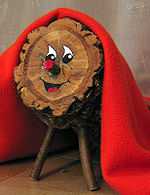Tió de Nadal
| The Catalan / Valencian cultural domain |
|---|
 Photograph of a typical contemporary Tió |
|
Language |
|
People
|
|
Geo-political divisions |
|
Government and politics |
|
Traditions and symbols |
The Tió de Nadal (Catalan pronunciation: [tiˈo ðə nəˈðaɫ], Western Catalan: [tiˈo ðe naˈðaɫ]; meaning in English "Christmas Log"), also known simply as Tió ("Trunk" or "Log", a big piece of cut wood) or Tronca ("Log") is a character in Aragones and Catalan mythology relating to a Christmas tradition widespread in Aragon and Catalonia. A similar tradition exists in other places such as the Cachafuòc or Soc de Nadal in Occitania. In Aragon is also called Tizón de Nadal or Toza.
Often popularly called Caga tió ("Shitting log"), Poo log,[1] the form of the Tió de Nadal found in many Aragones and Catalan homes during the holiday season is a hollow log of about thirty centimetres length. Recently, the Tió has come to stand up on two or four little stick legs with a broad smiling face painted on the higher of the two ends, enhanced by a little red sock hat (a miniature of the traditional Aragones and Catalan barretina) and often a three-dimensional nose. Those accessories have been added only in recent times, altering the more traditional and rough natural appearance of a dead piece of wood.
Beginning with the Feast of the Immaculate Conception (December 8), one gives the tió a little bit to "eat" every night and usually covers him with a little blanket so that he will not be cold at night. Story goes that in the days preceding Christmas, children must take good care of the log, keeping it warm and feeding it, so that it poops Christmas trees on Christmas day, hence the name caga tio (literally poo log).[2]
On Christmas day or, depending on the particular household, on Christmas Eve, one puts the Tió partly into the fireplace and orders it to defecate; the fire part of this tradition is no longer as widespread as it once was, since many modern homes do not have a fireplace. To make it defecate one beats the Tió with sticks, while singing various songs of Tió de Nadal.
The tradition says that before beating the Tió all the kids have to leave the room and go to another place of the house to pray asking for the tió to deliver a lot of presents. This makes the perfect excuse for the relatives to do the trick and put the presents under the blanket while the kids are praying.
The tió does not drop larger objects, as those are considered to be brought by the Three Wise Men.[3] It does leave candies, nuts and torrons. Depending on the part of Catalonia, it may also give out dried figs. When nothing is left to "shit", it drops a salt herring, a head of garlic, an onion, or it "urinates" by leaving a bowl of water. What comes out of the Tió is a communal rather than individual gift, shared by everyone present.
In addition to the names listed in the opening paragraph, the additional nickname Caga tió (pronounced: [ˈkaɣə tiˈo] or [ˈkaɣa tiˈo], "shitting log")[4] derives from the many songs of Tió de Nadal that begin with this phrase, which was originally (in the context of the songs) an imperative ("Shit, log!"). The use of this expression as a name is not believed to be part of the ancient tradition.

Caga tió song
| "Caga tió, caga torró, |
shit, log, shit nougats (turrón), |
Two alternate versions goes something like this:
| "Caga tió, tió de Nadal, |
shit, log, log of Christmas, |
| "Tronca de Nadal, Caga torrons, |
log of Christmas, shit nougats, |
After hitting it softly with a stick during the song, it is hit harder on the words Caga tió!. Then somebody puts their hand under the blanket and takes a gift. The gift is opened and then the song begins again. There are many different songs: these are just examples.
See also
![]() Media related to Tió de Nadal at Wikimedia Commons
Media related to Tió de Nadal at Wikimedia Commons
- Bûche de Noël
- Yule log
References
- ↑ "'Tis the season: How Christmas is celebrated around the world". The Independent. 23 December 2014. Retrieved 23 December 2014.
- ↑ Patge, Gregori (2010). Catalan Mythology: Aragones and Catalan Mythology about Witches, Tubal, Tió de Nadal, Minairó, Aloja, Dip, Catalan Myths and Legends (1st ed.). UK: General Books LLC. ISBN 1157085865. Retrieved 23 December 2014.
- ↑ "Christmas in Barcelona". International House Language Services.
- ↑ Letcher, Piers (17 November 2005). "A continental Christmas". The Guardian.
| ||||||||||||||||||||||||||||||||||||||||||